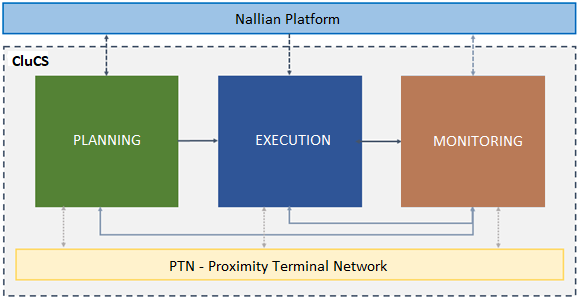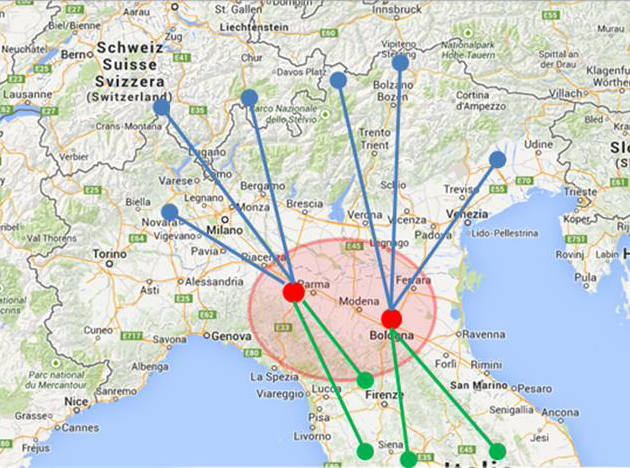CluCS applied to a Proximity Terminal Network
Logistics terminals operating in a region typically work independently from other terminals without joint management tools that could improve overall performance and provide smart specialized services as a cluster of hubs. Focusing on this, Cluster Community System (CluCS) optimizes the functioning of the Proximity Terminal Networks (PTN) through its IT platform. In this way, CluCS also aims to enhance efficiency and competitiveness of the logistics actors operating in the region.
Cluster Community System (CluCS) supports the governance of PTN and operations through the efficient management of information: cargo flows and assets within the nodes of the PTN and in relation to the surrounding logistics nodes, especially ports configured as the Cluster. This will allow a coordinated management of multiple hubs with different specializations, creating synergies and linking the cluster to different TEN-T corridors. The CluCS aims to establish co-ordination and collaboration between neighbouring and regional terminals on the one side and pooling cargo under co-ordinated processes on the other side. CluCS will transfer and advance on methods and research results as developed in the context of Port Community Systems (PCS) towards a cluster context advancing from previous initiatives.

Cluster basic functional rationale
CluCS will consider specific services within the Cluster to involve industry and manufacturing sectors by adding enhanced functionalities on:
- Planning functionalities should cover the possibility for the customers and transport services to match. The following features are needed in a functioning Cluster environment:
- service publishing;
- service booking;
- service planning and coordination with under/above-standing transport chain sections.
- Execution, seen as a dynamic process, able to take into account the possibility of enhancing the services offered through real time adaption to supply chain conditions. This means it has to interact constantly with the Monitoring phase. The following features are considered:
- road transport cargo bundling;
- terminal operations;
- logistics services;
- real time adaptation.
- Monitoring is a dynamic phase interacting with both Planning and Execution to: (i) keep the status of services constantly up-to-date; (ii) suggest the needed adaptations. Basic functions for Monitoring are:
- real time monitoring;
- iterative link with Planning and Execution;
- full visibility of under and above –standing supply chain sections monitoring tools.
This Living Lab acts at Cluster level to test and validate into a real business context the CluCS. Furthermore, the Living Lab also enables the establishment of value added services (e.g. co-packing and shipment consolidation, late product differentiation, assembling and testing, logistics process tracking, vehicle load factor optimisation, last mile optimisation and connections with cities, single booking window). The Living Lab testing activities are performed with stakeholders and users by enabling the building and strengthening of complementarities among hubs, platforms and services in the Cluster itself, thus including smart specialization of operations, maximization of throughput and solving the issue of the lack of balanced collaboration with other proximity terminals and hubs in the same region.

Bologna PTN
Main execution sites for the Living Lab are
- the Bologna Freight Village PTN
- the Cluster involving Bologna Freight Village and the Trieste Port.
Both hubs are part of the TEN-T Core Network. In a progressive way, the Bologna PTN will involve the close regional terminals of Parma and Marzaglia. Then, the extension at Cluster level targeting synergies and collaboration with the Bologna PTN will be achieved, also involving major shippers, industries and manufacturers.


